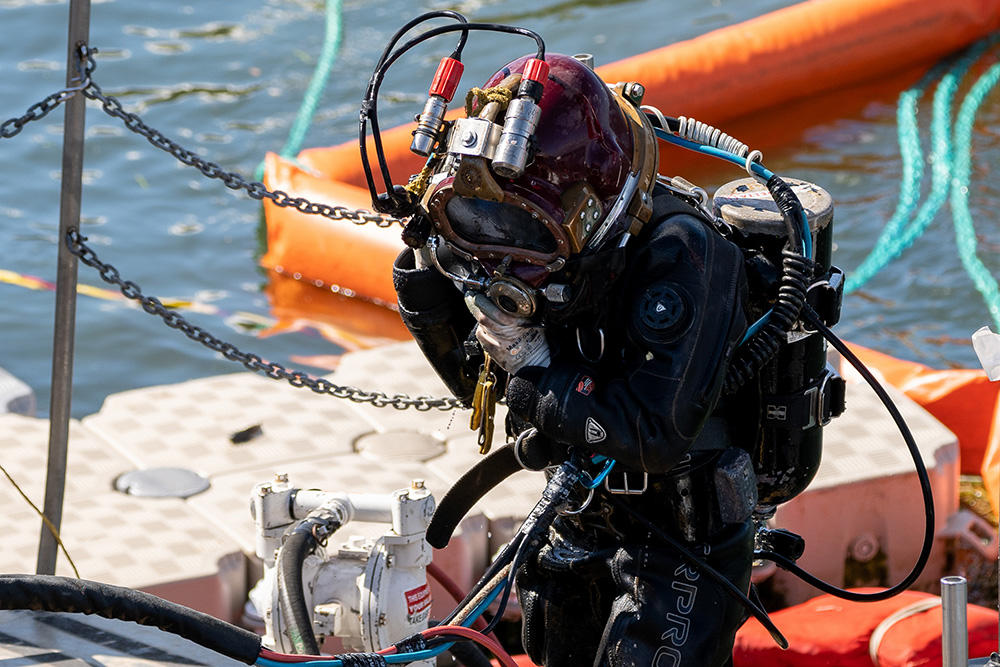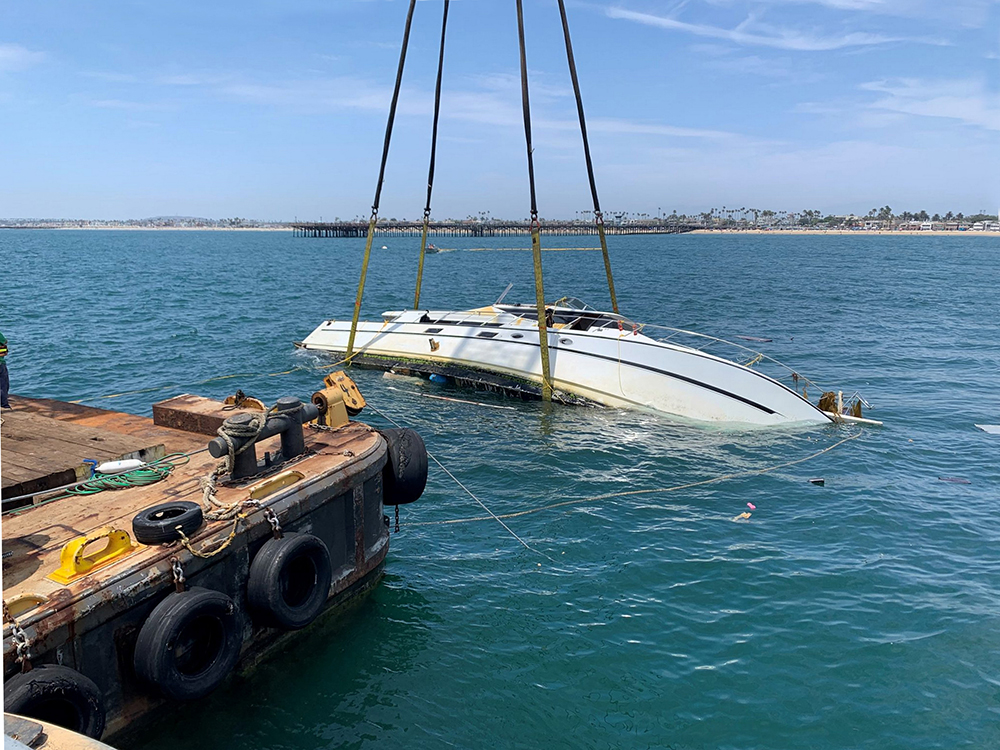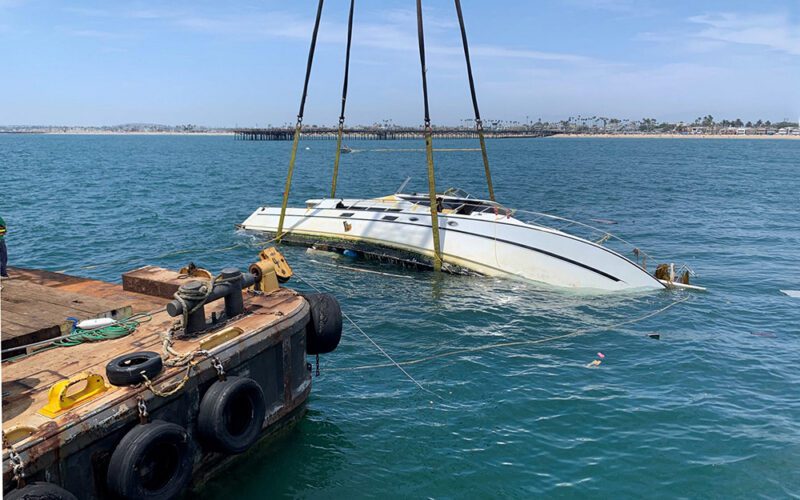
Above the surface or underwater, oil and hazardous material spill response and recovery in marine environments is making strides, thanks to technological advances and equipment upgrades, resulting in safer and more efficient work.
Autonomous systems are gaining traction, helping increase safety and productivity. Drones are helping make the job more efficient and practical. Skimmers, containment vessels and collection systems are showing promising improvements in both volume and recovery efficiency. Crane barges and other supporting craft utilized in responding to incidents are showing strength and maneuverability in recent case studies.
Staying on top of technological advances goes hand in hand with responding to environmental incidents. To learn more about recent developments, Pacific Maritime reached out to industry leaders.
Global Diving and Salvage
With decades of experience, Global Diving and Salvage understands that responding quickly and efficiently is vital to the health of the natural environment.
Aaron Harrington, the company’s director of casualty response, noted that there hasn’t been much of a shift in recent years regarding the basic process of oil or hazardous material spills. The task has stayed the same: Contain it and recover it. Yet how it’s done has changed, he added.
Advancing technology has played a big role in how the task has evolved over the years. Most recently, the development and use of autonomous vessels for oil skimming and containment is gaining traction in the industry, Harrington pointed out.
Removing the human element by using this type of cutting-edge technology can be a benefit from a safety perspective.
Autonomous vessels also allow contractors and the industry to counter the personnel shortage delta that many industries are facing with the graying of the workforce, Harrington said.
Finding enough people to actually do the work is a big factor in the industry, he added. It’s difficult to find workers that are available for unscheduled work on a 24/7 basis. People aren’t waiting around for the phone to ring when these types of incidents happen in gnarly weather in the middle of winter, he said.
So autonomous vessels can help fill in the gap.
Vessel Autonomy
Boston-based Sea Machines Robotics successfully demonstrated the industry’s first spill-response vessel in late 2019. As a part of its cooperative agreement with the U.S. Department of Transportation Maritime Administration, Sea Machines deployed its autonomous systems on board a Kvichak Marco skimmer boat owned by Marine Spill Response Corp. during an event at the Portland harbor.
Officials note the technology’s ability to increase the safety, productivity and predictability of response for marine oil-spill operations.
“The safety of our personnel is the most important consideration in any response,” John Swift, Marine Spill Response’s Atlantic region and marine division vice president, said. “Autonomous technology enhances safe operations.”
The SM300-equipped skimmer boat was remotely controlled from an onshore location and showed the capability for ENC-based mission planning, autonomous waypoint tracking, autonomous grid-line tracking, and collaborative autonomy for multi-vessel operations. A wireless remote payload control deployed on-board boom, skimmer belt and other response equipment.
Additionally, Sea Machines detailed how to operate the skimmer in an unmanned autonomous mode, which enables operators to respond to spill events 24/7 depending on recovery conditions, even when crews are restricted.
These configurations also reduce or eliminate exposure of crewmembers to challenging sea and weather, toxic fumes and other safety hazards.
“We’ve proven that our technology can be applied to the marine spill response industry—as well as other marine sectors—to protect the health and lives of mariners responding to spills,” Sea Machines founder and CEO Michael G. Johnson stated in a news release.
Autonomous technology is also working underwater in response to oil leaks.
Engineers from Woods Hole Oceanographic Institution recently developed a system that can autonomously detect and sample underwater oil plumes. Daniel Gomez-Ibanez, Amy L. Kukulya, and Abhimanyu Belani invented the Midwater Oil Sampler, which collects multiple 1-L samples of seawater when preset criteria are met.
According to an article they authored and published in April in the Journal of Marine Science and Engineering, the sampler has a hydrocarbon-free sample path and can be configured with several modules of six glass sample bottles.
A REMUS 600 autonomous underwater vehicle was used for sampling, as it’s large enough to comfortably accommodate several 1-liter bottles, along with associated sensors. It can operate to a 600-meter depth.
For oil-spill response, the REMUS 600 AUV was configured with several in-situ sensors along with the newly developed Midwater Oil Sampler. The sensor suite included a Licor LI-192 photosynthetically active radiation (PAR) sensor, Seabird Sea-OWL fluorometer, Anderaa 4831F optode, Seascan Holocam and a GoPro Hero 3 video camera.
In the JMSE article, the authors also share details from a multi-agency cooperative exercise that located, mapped and sampled naturally occurring oil seeps offshore of Santa Barbara, Calif., in 2019.
Drones
Another revolutionary change in the spill-response industry in recent years has been the use of drones. What previously required a helicopter or satellite imagery, can now be done with an unmanned aerial vehicle, although it should be noted that mariners also need a remote pilot certificate from the Federal Aviation Administration in order to operate one.
Remotely controlled drones have been incredibly helpful for continual surveillance during an oil or hazardous material spill, Harrington noted, calling them “instrumental for initial and continued assessments during oil spills.”
Safe Harbor Pollution Insurance officials note on the firm’s website that “drones have the potential to be invaluable” for spill response teams.

UAVs can help contain and control worst-case scenarios by improving situational assessments, reducing health and safety risks and deploying much faster than traditional aircraft. They can also help track offshore oil slicks and evaluate damage to vessels.
“Drones are incredibly efficient at collecting crucial data during an environmental emergency,” the insurance officials note. “Response teams can use footage from drone flights to identify, map and measure oil buildup on coastlines, particularly in areas that can’t be accessed via foot.”
Authors Bilal Hammoud and Norbert When propose a new solution, wide-band radar on drone platforms, in an open-access book published in September from IntechOpen about advances in oil spill monitoring using drone-based radar remote sensing.
Hammoud and When, part of the Microelectronic Systems Design Research Group at Technical University in Germany, note that in order to reduce the impact of oil spills and respond faster to incidents, it’s crucial to have an efficient system to detect slicks, estimate thickness and determine oil classification.
“This work shows that by processing radar power reflectivity values, taken from nadir-looking systems under weather conditions suitable for cleaning operations, thick oil-slick thicknesses up to 10 mm can be detected, estimated and classified,” they explain in the chapter.
Radar systems on drones are capable of using “high spectral resolution and parallel scanning” to do that work and provide valuable information to contain the damage.
“Visible and ultraviolet cannot work at night. Moreover, infrared sensors cannot provide estimations of thicknesses. Therefore, we select radar sensors for the proposed monitoring system because they operate during the day and night and under all weather conditions,” Hammoud and When explain.
They suggest incorporating “both C-band and X-band using remote sensing nadir-looking wide-band radar sensors that can be implemented on drones as oil spill monitoring systems.”
“Our new approach targets the spills happening during calm and moderate ocean conditions, which are challenging for state-of-the-art SAR systems,” they stated.
The idea aims to provide a complementary system to satellite SAR systems.
“During the early stages of a possible oil spill, drone systems act as small-scale tactical-response systems improving the large-scale surveillance obtained by satellite systems,” Hammoud and When wrote. “Over the spill duration and based on satellite scans, the drones can track the spill using the high spatial resolution feature provided by the mounted wide-band radars.”
New technology is also helping improve software used in spill response.
The Center for Operational Oceanographic Products and Services is working on a new data-visualization product that will include dissemination of surface current observations and predictions from high frequency radar stations in San Francisco Bay, Chesapeake Bay, New York Harbor and Delaware Bay.
The product is expected to be available in late 2024.
National Oceanic and Atmospheric Administration officials emphasized the benefit to oil spill response (and other services and programs) in a statement. The program provides surface current observations and tidal current predictions for coastal areas in near real time.
Global Technology
Around the world, experts are using modern tech for solutions to respond to oil spills.
The Commonwealth Scientific and Industrial Research Organisation (CSIRO), an Australian government agency responsible for scientific research, noted a need to need to quickly separate and remove from the seawater, including at very low concentrations. The government of Canada funded CSIRO scientists to create the new spill-response technology, which focuses on removing these droplets.
The process includes taking a typical domestic sponge and coating it with a special superhydrophobic polystyrene-based polymer. The coating is also very efficient at separating oil from water emulsions, so the oil soaks into the sponge and the water wicks away.
The sponge material is cheap and scalable. It also can be easily recycled and reused after it’s been mechanically compressed.
“Best of all, our technology can be used after the bulk of the oil is removed,” CSIRO researchers explain on the group’s website. “This is when there the oil is at extremely low—but still environmentally harmful—concentration in the water. The hydrophobic sponges can separate oil from water even with extremely low concentrations (of) lower than 1000 ppm.”
The new technology allows oil spills to be cleaned at sea.
“This is a cheaper, faster way to treat oil spills, ultimately helping reduce the impact on our marine life,” officials note.
The team is now scaling the synthesis of the materials and carrying out trials with the ultimate goal of large-scale deployment.
The technology for skimmers has improved in recent years as well, Global Diving and Salvage Harrington said, noting “advancement in skimmers, both in size and recovery efficiency.”
CRUCIAL, Inc. manufactures and distributes oil spill containment and recovery equipment and has continually improved the design of disc and drum skimmers.
CRUCIAL’s patented “fuzzy technology” has proven to be a game-changer. According to company officials, it’s increased recovery rate has been recognized and certified by the U.S. Coast Guard as among the highest recovery rates of any technology.
The Louisiana-based company also has designed the Magna ORD disc skimmer, which has multiple sets of oil recovery discs for greater recovery capacity for larger, offshore spills.
Other equipment used in spill-response work have been upgraded recently as well.
Resolve Marine Manager Todd Duke pointed to some improvements QualiTech Environmental is working on for their Current Buster oil collection system.
“It is showing a lot of promise,” he said.
The NOFI Current Buster technology contains and controls oil spills with minimum loss at up to 5-knots towing speed, according to the QualiTech website. It incorporates separators combined with temporary storage units and can be operated as a single vessel sweep system in combination with BoomVane systems that are available in four different sizes depending on application.
In April 2022, QualiTech, along with its partner, AllMaritim AS, debuted redesigned NOFI Current Buster technology at the Spill Control Association of America meeting.
The deployment of the updated NOFI Current Buster 4 was conducted alongside Marine Spill Response Corporation, which currently operates 19 NOFI Current Buster 4s and five NOFI Current Buster 2s.
“We successfully deployed and recovered the system in under 30 minutes without any safety incidents,” QualiTech Environmental Operation Manager Josh Clifford said.
Other vessels used to aid in responding to oil and hazardous material spills are performing precise and skilled work in tricky situations, as demonstrated in several recent case studies.
Pacific Maritime Group Vice-President Business Development Robbie Adair noted an incident when PMG was hired to respond to a 65-foot yacht that hit the rocks near Seal Beach, Calif. The boat was a total loss, Adair noted, but nobody was injured.
The Godfather was reported partially sunk and drifting roughly a mile offshore on July 15, 2021, with roughly 500 gallons of diesel on board.
“It had reportedly run into Island Chaffee at high speed in the night. The vessel did not entirely sink, though, and bobbed in the waves,” PMG notes on their website. “As such it was deemed to present a hazard to navigation as well as a potential hazardous material spill.”
Global Diving was contracted to take charge. Divers reported significant damage. The Godfather’s bow was afloat with its stern sometimes dragging, while at times anchored by its propeller. Too many gashes in the hull made it impossible to be refloated with pumps alone.
“This was a job for a heavy lift,” PMG officials wrote.
PMG’s DB San Diego was hired to assist and raise the motorcraft out of the water.
The crane barge has a 300-ton turner crane aboard specifically for jobs like this, Adair noted. Float bags were used to bring The Godfather fairly level to the surface. Wide nylon straps went around the hull and the DB San Diego carefully lifted the craft out of the water and aboard the PMG deck barge YC-1.
“The job went well,” PMG officials concluded.
Divers scoured the sea bottom for other items that broke free from the wreck, including engines and fuel tanks, which were also placed aboard the YC-1. They headed to the PMG yard in Long Beach, Calif., and the wreck was demolished, with the remains of the yacht taken to a landfill.
DB San Diego was PMG’s first big offshore heavy-lift crane barge. It was built as a platform capable of four-point mooring and providing underwater project support, underwater pipeline service, oil platform service and more. It has a gross tonnage of 744 tons.
Pacific Maritime Group also helped clean up a diesel fuel spill in a particularly challenging environment in Laguna Beach in late 2021. Ancon Services mobilized onto a small beach that was inaccessible from the street. All equipment and materials had to be delivered by sea. PMG’s landing craft Sea Scout delivered an excavator, skidsteers, all-terrain vehicle, containment boom, bags and absorbents.
During a spill response in Astoria, Ore. in summer 2022, Global Diving recovered about 525 gallons of diesel from a partially sunk historic ferry that also had sorbents and active pumping. Five cubic yards of hazardous material were recovered.
On July 28, the 1924 former wooden-hulled car ferry, Tourist No. 2, was partially submerged and sheening when the Columbia River sector of the Coast Guard contacted NOAA scientific support coordinators.
A 300-foot by 400-foot sheen was observed around the vessel located among pilings offshore of 6th Street. A containment boom was deployed around the ferry.
“Despite extensive damage to the starboard side of the vessel,” Lt. Cmdr. Jarrod Pomajzl, the Incident Management Division Chief at Coast Guard Sector Columbia River said, “Global was able to mitigate a significant threat to the environment and Columbia River as a whole.”
Sara Hall has 15 years of experience at several regional and national magazines, online news outlets, and daily and weekly newspapers, where coverage has included reporting on local harbor activities, marine-based news, and regional and state coastal agencies. Her work has included photography, writing, design and layout.

